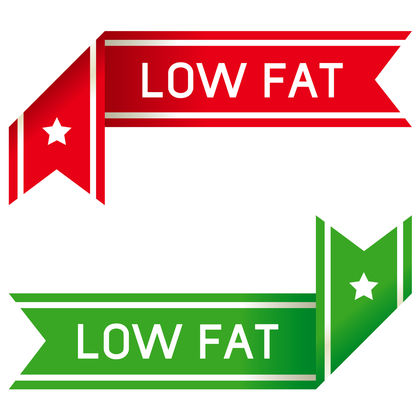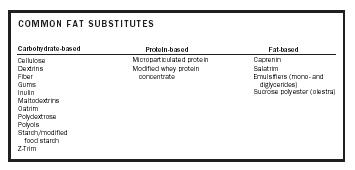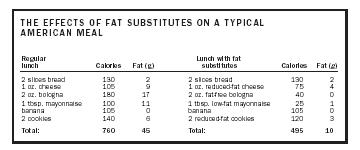Fat Substitutes

Since the late 1980s, fat-free and reduced-fat foods have become widely available. While not all new products survive the competitive marketplace, thousands of new reduced-fat and fat-free products have been introduced each year since 1990.
In part, these new reduced-fat food products are the result of consumer demand. But they are also a response to public health concerns and initiatives. In 1990, Healthy People 2000 asked food manufacturers to double the availability of reduced-fat food products by the year 2000, a goal that was easily met.
Dietary Fat: A Good Thing in Moderation
Despite fat's bad reputation, it is a very important nutrient . Dietary fat plays many critical roles in the body, such as providing essential fatty acids , fat-soluble vitamins , and energy . It also serves structural functions in hormones and in cells.
Fat is also a key factor in how foods taste. Fat absorbs the essence of spices and flavors and allows people to experience their full aroma. Not only does fat carry flavor, it also determines whether a cookie crunches or a muffin
![Fat substitutes come in several varieties, including carbohydrate-based substitutes and protein-based substitutes. A more recent innovation is the fat-based substitute called olestra, which is an indigestible molecule that cannot be absorbed by the body. [Octane Photographic. Reproduced by permission.]](../images/nwaz_01_img0094.jpg)
Since the 1970s, nutrition scientists have researched the effects of diet on chronic diseases. Eating a diet lower in fat, saturated fat , and cholesterol appears to help prevent or delay the development of some serious illnesses, such as certain cancers and heart disease .
Most government health agencies and professional health organizations encourage people five years old and older to eat a diet with less than 30 percent of total calories from fat, and less than 10 percent of that from saturated fat.
Consumers are concerned about nutrition, and they want to moderate the fat in their diet but there are challenges to overcome. Nutrition, price, convenience, and product safety are important, but taste is the key driver behind food selection for most people. And many consumers still think that less fat means less taste. Fat substitutes were developed to help meet consumers' expectations about taste while providing fewer calories from fat.
What Are Fat Substitutes?
Substitutes, or fat replacers, provide the sensory and functional qualities normally provided by fat. For example, fat provides moistness in baked goods, texture in ice cream, and crispiness in potato chips. Because fat has so many diverse functions in foods, it is virtually impossible to replace it with a single compound or process. The ingredients used in place of fat depend on how a food product will be eaten or prepared. For instance, not all fat-substitute ingredients are stable when heated, so the type of fat substitute used in a fat-free salad dressing may not work well in a muffin mix.
Many fat substitutes are simply old ingredients used in new ways. For example, the Food and Drug Administration (FDA) approved polydextrose for use as a moisture-binding agent in the early 1980s, but more recently it

| Carbohydrate-based | Protein-based | Fat-based |
| Cellulose | Microparticulated protein | Caprenin |
| Dextrins | Modified whey protein concentrate | Salatrim |
| Fiber | Emulsifiers (mono- and diglycerides) | |
| Gums | ||
| Inulin | Sucrose polyester (olestra) | |
| Maltodextrins | ||
| Oatrim | ||
| Polydextrose | ||
| Polyols | ||
| Starch/modified food starch | ||
| Z-Trim |
has been used as a fat substitute. Carrageenan has been used since the early 1960s as an emulsifier, stabilizer, and thickener, but is now commonly used to replace fat in foods, as is guar gum , which has been used as a thickener for nearly a hundred years.
Some fat substitutes are newer to the food supply, though they are made from familiar ingredients. For example, microparticulated protein is made from milk, egg, or whey protein. Other fat substitutes are new ingredients made from combinations of basic molecules .
In some cases, the FDA has approved fat-reduction ingredients as food additives . To be approved, food additives are tested extensively to assess their safety and level of use among different population groups. Examples of fat substitutes approved as food additives include carrageenan, olestra, and polydextrose.
In other instances, fat-reduction ingredients are "generally recognized as safe" (GRAS). GRAS ingredients are made from common food components and are considered by experts to be safe. For example, many spices and flavoring agents, such as sugar and salt, are GRAS ingredients. Examples of GRAS fat substitutes include guar gum and maltodextrin.
Categories of Fat Substitutes
Fat-substitute ingredients fall into three categories: carbohydrate-based, protein-based, and fat-based. Carbohydrate-based fat substitutes are the most common. They are very versatile and found in many types of food products. Carbohydrate-based fat substitutes provide between zero and four calories per gram. When used to replace fat, they may significantly lower the calorie content of a food. Most carbohydrate-based fat substitutes are GRAS substances. Some of these ingredients are only partially digestible. However, when consumed at expected levels, most carbohydrate-based fat substitutes have no digestive effects. Guar gum is an example of a carbohydrate-based fat substitute.
Protein-based fat substitutes are not as numerous as carbohydrate-based ingredients, but they have many applications and can be used in many products, including cheese, yogurt, sour cream, ice cream, mayonnaise, and salad dressing. Protein-based fat substitutes cannot be used for deep-frying. Whey protein concentrate is a protein-based fat substitute.

| Regular | Lunch with fat | ||||
| lunch | Calories | Fat (g) | substitutes | Calories | Fat (g) |
| 2 slices bread | 130 | 2 | 2 slices bread | 130 | 2 |
| 1 oz. cheese | 105 | 9 | 1 oz. reduced-fat cheese | 75 | 4 |
| 2 oz. bologna | 180 | 17 | 2 oz. fat-free bologna | 40 | 0 |
| 1 tbsp. mayonnaise | 100 | 11 | 1 tbsp. low-fat mayonnaise | 25 | 1 |
| banana | 105 | 0 | banana | 105 | 0 |
| 2 cookies | 140 | 6 | 2 reduced-fat cookies | 120 | 3 |
| Total: | 760 | 45 | Total: | 495 | 10 |
The last category of fat substitutes includes those that are fat-based. Because they are made from fat, they often come closest to providing fat's taste and cooking properties. Most Americans have heard of olestra, which is a fat-based fat substitute made from sucrose (table sugar) and fatty acids from vegetable oils. However, unlike sugar and vegetable oils, the body does not absorb olestra because the human digestive enzymes cannot break down such a large molecule. Olestra has the potential to inhibit absorption of some fat-soluble nutrients in the digestive tract, and, to offset any possible effects, products made with olestra have appropriate amounts of vitamins A, D, E, and K added.
Ensuring Safety
Most fat substitutes are not new to the food supply. Ingredients that are new, or used in new ways, must meet the FDA's strict criteria to be either classified as GRAS or approved as food additives. Whether they are GRAS or food additives, those ingredients approved for use in foods are considered safe for people of all ages.
Can Fat Substitutes Help to Reduce Dietary Fat?
Several studies have shown that using reduced-fat versions of food products can significantly reduce the amount of fat that people eat. For some people, eating less fat may lead to eating fewer calories and, eventually, to weight loss. As illustrated in the table above, by using reduced-fat foods, a typical lunch can be trimmed of one-third of its calories and three-fourths of its fat.
A common misconception about reduced-fat foods is that they also are low in calories. For many products, however, this is not the case. Most reduced-fat foods have had other ingredients added to replace the texture or flavor provided by fat, so that while the calories may be slightly lower in a fat-reduced product, the difference between it and a full-fat product may not be significant. With fat-modified products, as with all foods, portion size and calories still count.
Fat-modified foods can fit into a healthy eating plan. According to the American Dietetic Association, they offer a safe, feasible, and effective means to maintain the palatability of diets that are controlled in fat or calories. But they are only one of the many tools that can be used to achieve nutrition goals. Foods with fat substitutes should be consumed as part of an overall healthful eating plan, such as that outlined in the Dietary Guidelines for Americans.
SEE ALSO Artificial Sweeteners ; Dietary Guidelines for Americans ; Fats .
Susan T. Borra
Bibliography
Diamond, L. (1997). "The Dietary Guidelines Alliance: Reaching Consumers with Meaningful Health Messages." Journal of the American Dietetic Association 97(3):247.
Hahn, N. I. (1997). "Replacing Fat with Food Technology." Journal of the American Dietetic Association 3:15–16.
Heimbach, James T.; Van Der Riet, Brooke E.; and Egan, S. Kathleen. "Impact of the Use of Reduced-Fat Foods on Nutrient Adequacy" (1997). Annals of the New York Academy of Sciences: Nutritional Implications of Macronutrient Substitutes 819:108–114.
Kurtzweil, Paula (1996). "Taking the Fat Out of Food." FDA Consumer 30(6).
Morgan, Rebecca; Sigman-Grant, Madeleine; Taylor, Dennis S.; Moriarty, Kristen; Fishell, Valerie; and Kris-Etherton, Penny (1997). "Impact of Macronutrient Substitutes on the Composition of the Diet and U.S. Food Supply." Annals of the New York Academy of Sciences: Nutritional Implications of Macronutrient Substitutes 819:70–95.
Internet Resources
American Dietetic Association (1998). "Position of the American Dietetic Association: Fat Replacers." Available from <http://www.eatright.com>
U.S. Department of Health and Human Services (1999). Healthy People 2000. Available from <http://www.health.gov/healthypeople>
U.S. Department of Health and Human Services, and U.S. Department of Agriculture (2000). Nutrition and Your Health: Dietary Guidelines for Americans, 5th ed. Available from <http://www.health.gov/dietaryguidelines>

Comment about this article, ask questions, or add new information about this topic: